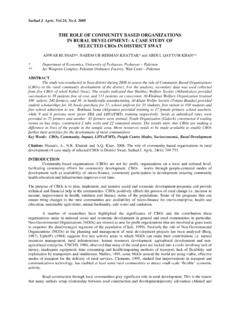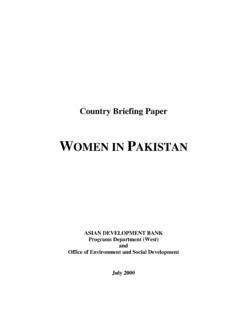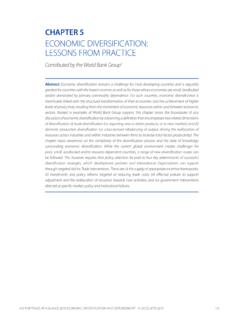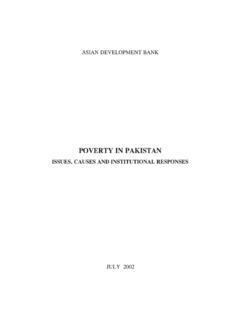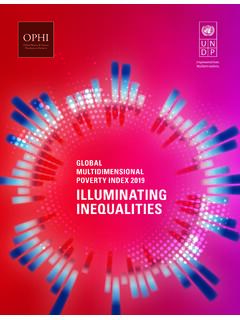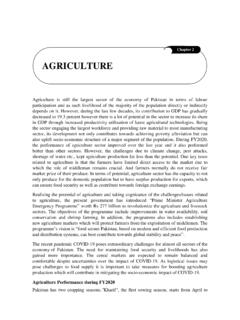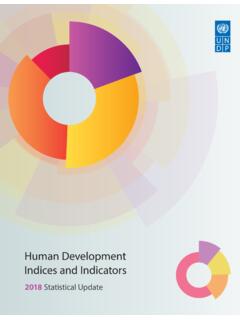Transcription of IMPACT OF GENDER DISCRIMINATION ON GENDER …
1 Sarhad J. Agric. , , 2011 329. IMPACT OF GENDER DISCRIMINATION ON GENDER . DEVELOPMENT AND poverty ALLEVIATION. ANWAR ALAM. Department of Sociology, University of Peshawar, Peshawar pakistan . ABSTRACT. This study focused on GENDER DISCRIMINATION and its IMPACT on development and poverty alleviation. To know the main reasons and areas of GENDER DISCRIMINATION and its IMPACT on development and poverty alleviation, the researcher selected 50 (25 male and 25 female) respondents in Hazar Khuani Peshawar on purposive sampling basis from the targeted respondents. Questionnaire was used for educated respondents and interview schedule foe uneducated respondents as the tool of data collection.
2 The study indicates that disparity exists in targeted area, which on many grounds affects poverty alleviation and development. The study indicates that women have no or low share in income / earnings of the family, that there was no equal status of women, female were not allowed to work out side home, women are more vulnerable to poverty , women share more burden of productive and household work, if household and productive burden share equally it could helps in poverty alleviation, household poverty could be reduced when both male and female members earn. Male members were the decision makers in their houses, there was no equal opportunity in higher education for women, women are facing difficulties in labour market, quality education can help in poverty alleviation.
3 GENDER inequality hinders poverty alleviation and female education helps in poverty alleviation. Women fertility right helps in poverty alleviation while DISCRIMINATION in distribution of resources affect poverty alleviation. The study depicts that if skill enhancement opportunities not provided to women equally it would affect poverty alleviation and GENDER development. Old traditional roles of men and women are hindering the woman participations in development and women have no property & political right in the area, which is negatively affecting poverty alleviation. Women have not given equal opportunities in different jobs except government job (teachers) in targeted area the reason was sex segregated occupational choices.
4 Women incomes were also low as compared to men and in most of the female respondents were totally dependent on men economically, which is also the reason of their exclusion from development and it affects poverty alleviation. For poverty alleviation and GENDER development there is need of policy formulation focused on women empowerment in education, employment, decision-making and providing legal, political, economic and social rights to women. Key Words: GENDER DISCRIMINATION , Data Collection, poverty Alleviation Citation: Alam, A. 2010. IMPACT of GENDER DISCRIMINATION on GENDER development and poverty alleviation.
5 Sarhad J. Agric. 27(2): 329-339. INTRODUCTION. The concept of human poverty sheds light on the relationship between GENDER inequalities and poverty ;. women are more vulnerable to chronic poverty because of GENDER inequalities in the distribution of income, access to productive inputs such as credit, command over property or control over earned income, as well as GENDER biases in labour markets. Resource allocation is often GENDER biased within households as well as in state and market institutions. It is often stated women do not always have full control over their own labour or in the income they earn. Men forbid their wives to work outside the household or extract labour from women through actual or threatened violence, making it harder for women to transform their capabilities into incomes or well being while GENDER inequalities reproduce the poverty of to the next they also have an IMPACT on growth performance and therefore have direct and indirect consequence on poverty and poverty alleviation.
6 Definition of GENDER GENDER refers to the social roles and status difference between women and men in a society. These roles are determined by the social, cultural and economic organizations of a society and the prevailing religious, moral and legal norms. 'Sex' is a biological term while GENDER a psychological and socio-cultural one (Anderson 1988). GENDER Inequality Today social class is based in the economy and in the status achieved within that realm. In the past social class rested in part on achieved status in the economic activities of the society, but also in great part on the ascribed status of the family.
7 That is one could earn position in the class system but family status helped gain and maintain that position. The ethnic and racial status affects ones position in the economy. GENDER , as defined by the society Anwar Alam. IMPACT of GENDER DISCRIMINATION on GENDER development and poverty alleviation 330. serves to assign position and worth in the society. Inequality based on GENDER exists within our society. The ascribed and achieved role and status of women, the relative power of men and women is discriminative in our society. There is GENDER inequality in role-play and rights (Oakley, 1972). Sex Ratios and Power Dependency The analysis of Marcia Guttentag actually focused upon power in the relationship between the sexes and how this affected the roles that each played within in the society in different contexts.
8 The theoretical perspective here focuses upon exchange theory and what each sex brings to the bargain (Marcia, 1996). Dyadic Power Dyadic power is the power in the one-to-one relationship between a husband and wife, between girl friend and boy friends. If there is an excess of one sex in the society, that the other sex will tend to have more power in this relationship because that sex is in short supply. Situation in America in the 60s and 70s because of the baby boom, women were in excess supply because of the human pattern of male selection. Typically men choose women who are from two to three years younger than they are.
9 In this time period the age structure was such that which were more women in these preferred age ranges than there were men. The result is that men lacked the dyadic power - they were experienced what Stark calls a power dependency. Simply put, the dependency of one member of a dyad on the other is equal to the person's inability to achieve his or her goals outside the dyad (Stark). Structural Power When women are in excess numbers they will use their numbers to shape the social structures. And this is indeed what we have found. Slack points to the roots of the suffragette movement in New England when men left and went west.
10 This can also help to explain the women's movement in the 60s and 70. An interesting trend is coming as the baby boomer age. Older individuals tend to be more politically active, and given the numbers, we can expect women to gain more influence and power in the society as a whole over the next several decades. The result should be more equality for women in all spheres of our society. Historical Perspective of GENDER Pre-industrial societies are usually rigidly age graded and sex-segregated. Age cohorts of males and females tend to pass through life in cohesive peer groups. Even after marriage, women and men tend to spend more time with their same sex peers than they do with their spouses.


